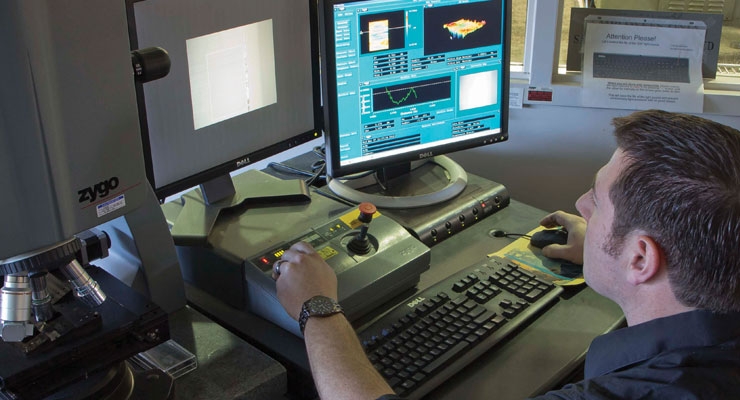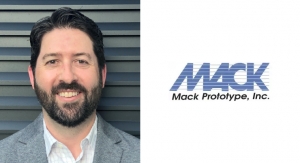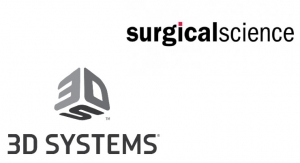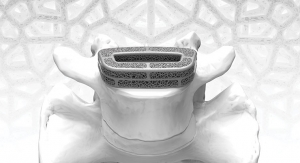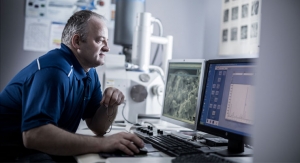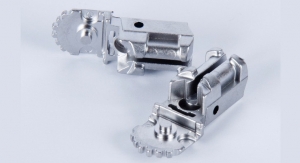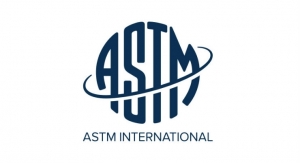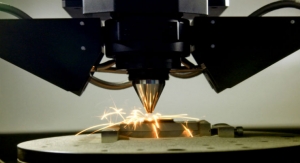Mark Crawford, Contributing Writer07.29.15
Contract manufacturers are almost too good at their jobs—when their customers raise the bar, they deliver. Original equipment manufacturers (OEMs) are getting to the point where they expect their manufacturing partners to come up with the technologies and processes needed to transform their most challenging designs into high-demand, cutting-edge products, all at reasonable price points.
As a result, it makes it harder to “keep up the good work” and stay ahead of what their clients will be asking for next.
Prototyping and production are critical phases of product development. OEMs want their devices to be smaller, stronger, lighter and more functional. They want faster turnaround times and faster market placement. They are eager to use additive manufacturing to see prototypes more quickly, or even make production-ready products. Even though they can be challenging to process, advanced materials with improved physical characteristics are in high demand because they perform better. Miniaturized devices and components require advanced technologies such as laser micromachining. To increase speed and quality and to keep costs down, automation and robotics now are in greater demand and doing more complex tasks.
Steve Hartzog, rapid prototyping/manufacturing engineering technician at Cadence Inc., a Staunton, Va.-based medical device contract manufacturer, indicates the two main trends he has seen over the last year is a desire for increased speed and additive manufacturing—where the first increasingly is hard to achieve without the second.
“Speed to turn around parts is at an ever-increasing premium,” said Hartzog. “The faster you can deliver a part, typically the faster a component or assembly can be assembled, tested, refined and prepared for commercialization. What makes this all happen faster is additive manufacturing. For example, 3-D printing of metal components is becoming a more attractive and readily available option for many components.”
Perhaps the greatest benefit of additive manufacturing, and the speed it brings to the production process, is lower operational cost—“depending on the part or component, additive manufacturing can reduce costs by up to 50 percent compared to standard production methods,” added Hartzog.
Manufacturability, Quality and Turnaround
Many medical device manufacturers are eager for feasibility or proof-of-concept prototypes to facilitate quick turnarounds prior to investing in prototype development. Not only can they verify that the design works, they also can determine the best solution for optimum manufacturability to reduce costs. In the prototyping stage, perfection is less important than being able to hold, feel and test the product—which is essential for supporting “proof of principle.”
Prototyping needs typically are significantly different from production demands.
“Customers are looking for different metals, smaller parts, thinner material and shorter lead times for both prototypes and production,” said John Marfiak, director of sales and marketing for Hudson Technologies, an Ormond Beach, Fla.-based contract manufacturer of implantable medical devices. “Most OEMs are also looking for multiple qualification lots, capability studies and advanced product quality planning, as well as supplier-managed stocking programs once the production runs have started.”
Speed always is important in the prototyping phase as engineers are iterating designs on the fly, whether it is for a balloon, catheter or braided shaft, according to Glenn Ogura, senior vice president of market development for Resonetics, a Nashua, N.H.-based provider of contract manufacturing services to the medical device industry, including laser drilling, cutting and etching.
“But even in the proof-of-concept phase, engineers are also asking for budgetary pricing in production, even before a single prototype has been made,” Ogura said. “Engineers want to know if the method of manufacturing is a viable choice as the volumes scale up. If not, then they prefer to search for an alternative method.”
OEMs also are pushing for faster turnaround. They are eager to get products developed quickly to meet market needs or customer requests. Sometimes they want prototypes within a matter of a few weeks. This can be a challenging timeline for their supply chains to meet, especially if the product is complex, newly innovative, or made of advanced materials that may be harder to acquire.
“We often get projects where parts are needed quickly,” said Ed Barbeau, tooling lead at Cadence’s Rhode Island facility. “This requires mating the material tolerances that will function properly with raw material manufacturers, within typical lead times. We also work to help with design for manufacturability so that dimensional requirements that are not critical to quality do not increase total part cost unnecessarily.”
And it’s not just controlling costs on new products—OEMs also want to save money on the devices they already have in production.
“We frequently receive requests for proposals regarding cost-saving solutions to existing product lines,” indicated Joshua Huffer, manufacturing engineer for Avalon Laboratories LLC, a Rancho Dominguez, Calif.-based manufacturer of wire-reinforced catheters and tubing for medical device delivery systems. “This can sometimes be achieved by reducing or eliminating tight-tolerance specifications that are not essential for achieving the desired end result, which reduces manufacturing time and lot approval. Evaluation of production set-up and equipment to reduce costs can also shorten manufacturing time.”
Technology at the Forefront
Additive manufacturing, also called 3-D printing, of course, has everybody’s attention. The field is evolving at a rapid pace—every new machine has more capacity for faster print speeds, larger pieces, more exotic materials, tighter tolerances, better surface finishes, and more production-like quality. Parts can be printed in both plastic and metal (typically stainless steel or titanium) to be used for prototypes and inspection or production fixture setup.
As devices and medical equipment become smaller and more complex, micromachining is required to produce delicate and/or small features. In the clinical diagnostics market, “sample to test” functionality and multiplex testing opens up new opportunities to use laser micromachining to fabricate consumables such as biochips, microfluidics, sample preparation filters and biosensors. Ultrafast lasers can be used on nearly every material type without cracking or thermal damage, as well as machining multiple features at the same time, reducing time and cost.
To produce multiple holes, for example, a laser beam can illuminate a non-contact mask so that the entire mask pattern is “imaged” on to the part.
“In fabricating a sample preparation filter, a micropore array containing hundreds of 5-micron-diameter holes can be drilled all at once,” said Ogura. “This parallel process is akin to lithography, except it is a single-step process and ensures tight tolerance of the hole diameter and the distance between holes, because the mask governs the pattern to be machined.”
Lasers also can be combined with Swiss machining centers to improve functionality and essentially create a one-stop machining center. This enables more accurate and precise machining capabilities that effectively can compete with higher-cost processing capabilities. For example, machined components that require both conventional machining and laser cutting typically require separate operations on a machining center and a laser cutter.
“Regardless of the order of operations, the second operation requires hand-loading single parts that were cut to length during the first operation,” stated Jay Nunes, manufacturing engineering manager for Cadence in Rhode Island. “The LaserSwiss allows both operations to be completed on one machine, significantly reducing cycle times. In addition, machining features with a laser as opposed to conventional machining eliminates the need for deburring and is significantly faster and more precise.”
The LaserSwiss machine also can produce quick prototypes for proof-of-concept testing and evaluation.
For example, it can cut a spiral-shaped area in a needle that will allow the needle to flex like a child’s flexi-straw. This added feature gives surgeons more flexibility during delicate procedures. Cutting these prototypes to test the effectiveness of the spiral geometry would take three to four times longer, at three to four times the cost, on a standard machine.
“If the prototypes need adjusting, we can quickly tweak the cut profile on the LaserSwiss machine and make a few more for testing,” said Jack Abato, vice president of operations for Cadence.
It’s not just the latest technology that saves OEMs time and money—it is also best practices and analytical software that improves quality control, logistics and design for manufacturability. For example, finite element analysis (FEA) technology is being used more during the feasibility stage to virtually test the limits of the design specifications. FEA can determine if a design is robust enough to go ahead and start manufacturing the tooling. FEA simulation software also is highly effective for showing the customer where the product most likely will fail within the current design parameters. This knowledge reduces the number of iterations and shortens the product life cycle.
“FEA software, with input from the design specialist, allows for changes to be made in material type, material thickness, or part geometry to make a robust, predictive process for manufacturing the best possible component,” said Marfiak. “Our FEA investments have given us the ability to shorten quoting and prototype lead times. This has allowed us to reduce the amount of hard tooling iterations and decrease the time from purchase order to production.”
Marfiak also has noticed a trend in moving from linear geometric dimensioning and tolerancing (GD&T) to 3-D GD&T tolerances. Three-dimensional GD&T is a system for defining and communicating engineering tolerances. It uses a symbolic language on engineering drawings and computer-generated three-dimensional solid models that explicitly describe nominal geometry and its allowable variation. Hudson has invested in multiple 3-D measurement systems that allow automatic visual measurements of its close-tolerance medical components.
“Each one of these systems is multi-sensor capable, supporting touch and non-contact probes, as well as laser scanning capabilities,” said Marfiak. “Hudson has also upgraded the metrology software packages in these systems to keep pace with the latest measurement requirements from our customers. Statistical Process Control (SPC) software is used to monitor parts during production as well as final inspection. Some of this data can be uploaded directly to our partnering customers through internet portals.”
Another logistical challenge is managing production runs, which can vary from large-volume runs, small-volume runs for specialty products or customized products for individuals. For example, consider the differences between manufacturing a medical device and manufacturing a consumable used for clinical diagnostics. In the medical device field, companies tend to manufacture a few hundred thousand devices per year at a relatively high price point. In the diagnostic field, whether it is a cuvette for a point-of-care application or a biosensor, the annual volumes are in the millions, even tens of million of units per year, at relatively low price points.
“At such volumes, it is imperative to eliminate the labor needed to load the part into the laser micromachining system, unload the part, inspect and package for shipping,” said Ogura. “Automated part handling such as reel-to-reel, web handlers, bowl feeders and pick and place becomes critical, as well as 100 percent in-situ metrology where dimensions are measured on the fly.”
Advanced Materials
More OEMs are moving away from commercially pure (Grade 1) titanium toward alloyed titanium components. The reason for the move is that titanium alloys provide better performance if a patient requires magnetic resonance imaging; titanium alloys also provide the ability for a device’s battery to be charged through the patient’s skin. It also delivers improved telemetry for uploading/downloading information from the device to the doctor through an Internet or Bluetooth connection.
Titanium and its associated alloys are tough to machine and tend to gum up and wear tools very quickly. Titanium alloys are very brittle and resist the bending and draw forming that is standard manufacturing procedure. Many OEMs and industry experts believe the only way to form and/or deep-draw many titanium alloys is by using dangerous methods such as warm or hot forming or thermoplastic forming.
“This is inaccurate,” said Marfiak. “At Hudson, we have developed techniques that allow us form these titanium alloys using cold-forming methods, in geometries and tolerances that were thought impossible several years ago.”
Hudson Technologies has worked with several raw material suppliers to develop specifications that are tighter than the normal ASTM specifications, allowing the manufacturer to develop cold-forming processes to form these difficult alloys.
“By using our extensive catalog of tooling, we have been successful in working with our suppliers and drawing titanium alloys deeper and with tighter radii than was thought possible,” said Marfiak.
Another titanium alloy that is growing in popularity is nitinol. This nickel-titanium alloy exhibits the unique properties of shape memory and super-elasticity. These properties make it ideal for products such as stents, which must be flexible enough to be guided through blood vessels without puncturing them. Nitinol can be set into a specific shape by positioning it in a fixture and dipping the part and fixture in a hot slurry. Once heated to a specific temperature, it will hold its shape forever. Bend it out of shape and it springs back to its heat-set shape when released. Nitinol is, however, a very hard material that can be difficult to process.
“Processing this material requires considerable expertise to get the shape exactly as needed,” said Abato. “We continue to develop new ways to shape-set Nitinol, including using additive manufacturing to produce the tooling needed to form and hold the material as it is being set. We believe this will cut time to market significantly.”
Avalon Laboratories uses several polyurethane-based and silicone/polyurethane-based materials for different applications of polymer solution casting. The company continues to work with several suppliers to test and incorporate radiopaque, lubricous and more biostable materials in this unique process. Polymer solution casting can provide seamless material transitions that offer varied property profiles along the shaft of a medical device. The process starts with solvent solubility testing, followed by testing of materials for mechanical properties, processing capabilities and biocompatibility and internal prototyping.
“We are seeing increased interest in the benefits of polymer solution casting for thin-walled catheter applications using micro coils and hypotubes,” said Huffer. “Hypotubes allow the catheter stiffness profile to be dictated by the hypotube cut pattern, which can be varied along the entire length and allows for very different characteristics from the distal to proximal end. In some instances, removing the need for multiple durometer materials often simplifies to one liner material and one jacket material. Thin walls are also achievable with micro coils, but tend to require multiple durometer materials to achieve the desired stiffness profile.”
Moving Forward
The bottom line is that OEMs want to get their new products to market faster. One way to do this is shortening their supply chain to include only the most trusted and qualified vendors, who operate validated processes that are approved by the U.S. Food and Drug Administration (FDA). This improves communication and makes the 510(k) application process go more smoothly. The FDA regularly audits critical component suppliers and contract manufacturers to make sure operations are compliant. Fortunately, the FDA is not typically concerned with prototyping processes, unless they are delivering production-ready parts. So far, most prototyped parts are being used in labs on cadavers or with human-like “substitute” tissues.
Technology continues to push the limits of design and production. New advanced materials and processes like laser micromachining, additive manufacturing and vision systems continue to improve quality, tolerances and speed, with fewer secondary steps. Equipment manufacturers are moving quickly toward improving prototyping to the point where high-volume production of parts will be a reality. One way to assist this transition is through automation and robotics.
“Teachable robots are not far away from being able to perform critical operations with the accuracy and repeatability necessary to go from prototype to volume production,” said Abato.
For example, to produce laser-welded prototype assemblies (such as welding a rod onto a tiny blade), the first step is designing and building a fixture to hold the parts together at precisely the correct position during the welding process. This means that a design engineer must design the fixture, a machinist must manufacture the various parts and assemble the fixture, and a manufacturing engineer must test the fixture to ensure that it produces the assembly to the customer’s specifications. With robotics, however, the manufacturing engineer uses a common fixture plate to position the parts in the correct configuration and takes the probe attached to the robot’s arm and touches the part in three or four places to teach the robot where to start and finish its welding process.
“We’ve now taken two people out of the process and cut the time to produce the prototype from a few weeks to a few days,” said Abato. “Subsequent design changes made by the customer won’t require changes to a complex fixture—it will take just 15 minutes to reteach the robot a new welding path. Since the robot already knows how to weld the parts, going from prototype to production is simple.”
OEMs no longer believe in the impossible (which is in itself testimony to the expertise and innovative solutions that contract manufacturers continue to deliver). This, however, makes it harder to raise the bar consistently. With these kinds of OEM expectations, one of the most successful strategies for turning prototypes around more quickly and accurately is assigning a very knowledgeable and experienced person to coordinate (and even build) the prototype effort.
“There are so many suppliers doing great things that it is inevitable that only the moon or better is the expectation, not the exception,” said Hartzog. “It is paramount to have internal and external partners who understand the need for speed and are willing to expedite their own processes to help achieve success in meeting the ever-increasing demand for speed.”
Mark Crawford is a full-time freelance business and marketing/communications writer based in Madison, Wis. His clients range from startups to global manufacturing leaders. He also writes a variety of feature articles for regional and national publications and is the author of five books. Contact him at mark.crawford@charter.net.
As a result, it makes it harder to “keep up the good work” and stay ahead of what their clients will be asking for next.
Prototyping and production are critical phases of product development. OEMs want their devices to be smaller, stronger, lighter and more functional. They want faster turnaround times and faster market placement. They are eager to use additive manufacturing to see prototypes more quickly, or even make production-ready products. Even though they can be challenging to process, advanced materials with improved physical characteristics are in high demand because they perform better. Miniaturized devices and components require advanced technologies such as laser micromachining. To increase speed and quality and to keep costs down, automation and robotics now are in greater demand and doing more complex tasks.
Steve Hartzog, rapid prototyping/manufacturing engineering technician at Cadence Inc., a Staunton, Va.-based medical device contract manufacturer, indicates the two main trends he has seen over the last year is a desire for increased speed and additive manufacturing—where the first increasingly is hard to achieve without the second.
“Speed to turn around parts is at an ever-increasing premium,” said Hartzog. “The faster you can deliver a part, typically the faster a component or assembly can be assembled, tested, refined and prepared for commercialization. What makes this all happen faster is additive manufacturing. For example, 3-D printing of metal components is becoming a more attractive and readily available option for many components.”
Perhaps the greatest benefit of additive manufacturing, and the speed it brings to the production process, is lower operational cost—“depending on the part or component, additive manufacturing can reduce costs by up to 50 percent compared to standard production methods,” added Hartzog.
Manufacturability, Quality and Turnaround
Many medical device manufacturers are eager for feasibility or proof-of-concept prototypes to facilitate quick turnarounds prior to investing in prototype development. Not only can they verify that the design works, they also can determine the best solution for optimum manufacturability to reduce costs. In the prototyping stage, perfection is less important than being able to hold, feel and test the product—which is essential for supporting “proof of principle.”
Prototyping needs typically are significantly different from production demands.
“Customers are looking for different metals, smaller parts, thinner material and shorter lead times for both prototypes and production,” said John Marfiak, director of sales and marketing for Hudson Technologies, an Ormond Beach, Fla.-based contract manufacturer of implantable medical devices. “Most OEMs are also looking for multiple qualification lots, capability studies and advanced product quality planning, as well as supplier-managed stocking programs once the production runs have started.”
Speed always is important in the prototyping phase as engineers are iterating designs on the fly, whether it is for a balloon, catheter or braided shaft, according to Glenn Ogura, senior vice president of market development for Resonetics, a Nashua, N.H.-based provider of contract manufacturing services to the medical device industry, including laser drilling, cutting and etching.
“But even in the proof-of-concept phase, engineers are also asking for budgetary pricing in production, even before a single prototype has been made,” Ogura said. “Engineers want to know if the method of manufacturing is a viable choice as the volumes scale up. If not, then they prefer to search for an alternative method.”
OEMs also are pushing for faster turnaround. They are eager to get products developed quickly to meet market needs or customer requests. Sometimes they want prototypes within a matter of a few weeks. This can be a challenging timeline for their supply chains to meet, especially if the product is complex, newly innovative, or made of advanced materials that may be harder to acquire.
“We often get projects where parts are needed quickly,” said Ed Barbeau, tooling lead at Cadence’s Rhode Island facility. “This requires mating the material tolerances that will function properly with raw material manufacturers, within typical lead times. We also work to help with design for manufacturability so that dimensional requirements that are not critical to quality do not increase total part cost unnecessarily.”
And it’s not just controlling costs on new products—OEMs also want to save money on the devices they already have in production.
“We frequently receive requests for proposals regarding cost-saving solutions to existing product lines,” indicated Joshua Huffer, manufacturing engineer for Avalon Laboratories LLC, a Rancho Dominguez, Calif.-based manufacturer of wire-reinforced catheters and tubing for medical device delivery systems. “This can sometimes be achieved by reducing or eliminating tight-tolerance specifications that are not essential for achieving the desired end result, which reduces manufacturing time and lot approval. Evaluation of production set-up and equipment to reduce costs can also shorten manufacturing time.”
Technology at the Forefront
Additive manufacturing, also called 3-D printing, of course, has everybody’s attention. The field is evolving at a rapid pace—every new machine has more capacity for faster print speeds, larger pieces, more exotic materials, tighter tolerances, better surface finishes, and more production-like quality. Parts can be printed in both plastic and metal (typically stainless steel or titanium) to be used for prototypes and inspection or production fixture setup.
As devices and medical equipment become smaller and more complex, micromachining is required to produce delicate and/or small features. In the clinical diagnostics market, “sample to test” functionality and multiplex testing opens up new opportunities to use laser micromachining to fabricate consumables such as biochips, microfluidics, sample preparation filters and biosensors. Ultrafast lasers can be used on nearly every material type without cracking or thermal damage, as well as machining multiple features at the same time, reducing time and cost.
To produce multiple holes, for example, a laser beam can illuminate a non-contact mask so that the entire mask pattern is “imaged” on to the part.
“In fabricating a sample preparation filter, a micropore array containing hundreds of 5-micron-diameter holes can be drilled all at once,” said Ogura. “This parallel process is akin to lithography, except it is a single-step process and ensures tight tolerance of the hole diameter and the distance between holes, because the mask governs the pattern to be machined.”
Lasers also can be combined with Swiss machining centers to improve functionality and essentially create a one-stop machining center. This enables more accurate and precise machining capabilities that effectively can compete with higher-cost processing capabilities. For example, machined components that require both conventional machining and laser cutting typically require separate operations on a machining center and a laser cutter.
“Regardless of the order of operations, the second operation requires hand-loading single parts that were cut to length during the first operation,” stated Jay Nunes, manufacturing engineering manager for Cadence in Rhode Island. “The LaserSwiss allows both operations to be completed on one machine, significantly reducing cycle times. In addition, machining features with a laser as opposed to conventional machining eliminates the need for deburring and is significantly faster and more precise.”
The LaserSwiss machine also can produce quick prototypes for proof-of-concept testing and evaluation.
For example, it can cut a spiral-shaped area in a needle that will allow the needle to flex like a child’s flexi-straw. This added feature gives surgeons more flexibility during delicate procedures. Cutting these prototypes to test the effectiveness of the spiral geometry would take three to four times longer, at three to four times the cost, on a standard machine.
“If the prototypes need adjusting, we can quickly tweak the cut profile on the LaserSwiss machine and make a few more for testing,” said Jack Abato, vice president of operations for Cadence.
It’s not just the latest technology that saves OEMs time and money—it is also best practices and analytical software that improves quality control, logistics and design for manufacturability. For example, finite element analysis (FEA) technology is being used more during the feasibility stage to virtually test the limits of the design specifications. FEA can determine if a design is robust enough to go ahead and start manufacturing the tooling. FEA simulation software also is highly effective for showing the customer where the product most likely will fail within the current design parameters. This knowledge reduces the number of iterations and shortens the product life cycle.
“FEA software, with input from the design specialist, allows for changes to be made in material type, material thickness, or part geometry to make a robust, predictive process for manufacturing the best possible component,” said Marfiak. “Our FEA investments have given us the ability to shorten quoting and prototype lead times. This has allowed us to reduce the amount of hard tooling iterations and decrease the time from purchase order to production.”
Marfiak also has noticed a trend in moving from linear geometric dimensioning and tolerancing (GD&T) to 3-D GD&T tolerances. Three-dimensional GD&T is a system for defining and communicating engineering tolerances. It uses a symbolic language on engineering drawings and computer-generated three-dimensional solid models that explicitly describe nominal geometry and its allowable variation. Hudson has invested in multiple 3-D measurement systems that allow automatic visual measurements of its close-tolerance medical components.
“Each one of these systems is multi-sensor capable, supporting touch and non-contact probes, as well as laser scanning capabilities,” said Marfiak. “Hudson has also upgraded the metrology software packages in these systems to keep pace with the latest measurement requirements from our customers. Statistical Process Control (SPC) software is used to monitor parts during production as well as final inspection. Some of this data can be uploaded directly to our partnering customers through internet portals.”
Another logistical challenge is managing production runs, which can vary from large-volume runs, small-volume runs for specialty products or customized products for individuals. For example, consider the differences between manufacturing a medical device and manufacturing a consumable used for clinical diagnostics. In the medical device field, companies tend to manufacture a few hundred thousand devices per year at a relatively high price point. In the diagnostic field, whether it is a cuvette for a point-of-care application or a biosensor, the annual volumes are in the millions, even tens of million of units per year, at relatively low price points.
“At such volumes, it is imperative to eliminate the labor needed to load the part into the laser micromachining system, unload the part, inspect and package for shipping,” said Ogura. “Automated part handling such as reel-to-reel, web handlers, bowl feeders and pick and place becomes critical, as well as 100 percent in-situ metrology where dimensions are measured on the fly.”
Advanced Materials
More OEMs are moving away from commercially pure (Grade 1) titanium toward alloyed titanium components. The reason for the move is that titanium alloys provide better performance if a patient requires magnetic resonance imaging; titanium alloys also provide the ability for a device’s battery to be charged through the patient’s skin. It also delivers improved telemetry for uploading/downloading information from the device to the doctor through an Internet or Bluetooth connection.
Titanium and its associated alloys are tough to machine and tend to gum up and wear tools very quickly. Titanium alloys are very brittle and resist the bending and draw forming that is standard manufacturing procedure. Many OEMs and industry experts believe the only way to form and/or deep-draw many titanium alloys is by using dangerous methods such as warm or hot forming or thermoplastic forming.
“This is inaccurate,” said Marfiak. “At Hudson, we have developed techniques that allow us form these titanium alloys using cold-forming methods, in geometries and tolerances that were thought impossible several years ago.”
Hudson Technologies has worked with several raw material suppliers to develop specifications that are tighter than the normal ASTM specifications, allowing the manufacturer to develop cold-forming processes to form these difficult alloys.
“By using our extensive catalog of tooling, we have been successful in working with our suppliers and drawing titanium alloys deeper and with tighter radii than was thought possible,” said Marfiak.
Another titanium alloy that is growing in popularity is nitinol. This nickel-titanium alloy exhibits the unique properties of shape memory and super-elasticity. These properties make it ideal for products such as stents, which must be flexible enough to be guided through blood vessels without puncturing them. Nitinol can be set into a specific shape by positioning it in a fixture and dipping the part and fixture in a hot slurry. Once heated to a specific temperature, it will hold its shape forever. Bend it out of shape and it springs back to its heat-set shape when released. Nitinol is, however, a very hard material that can be difficult to process.
“Processing this material requires considerable expertise to get the shape exactly as needed,” said Abato. “We continue to develop new ways to shape-set Nitinol, including using additive manufacturing to produce the tooling needed to form and hold the material as it is being set. We believe this will cut time to market significantly.”
Avalon Laboratories uses several polyurethane-based and silicone/polyurethane-based materials for different applications of polymer solution casting. The company continues to work with several suppliers to test and incorporate radiopaque, lubricous and more biostable materials in this unique process. Polymer solution casting can provide seamless material transitions that offer varied property profiles along the shaft of a medical device. The process starts with solvent solubility testing, followed by testing of materials for mechanical properties, processing capabilities and biocompatibility and internal prototyping.
“We are seeing increased interest in the benefits of polymer solution casting for thin-walled catheter applications using micro coils and hypotubes,” said Huffer. “Hypotubes allow the catheter stiffness profile to be dictated by the hypotube cut pattern, which can be varied along the entire length and allows for very different characteristics from the distal to proximal end. In some instances, removing the need for multiple durometer materials often simplifies to one liner material and one jacket material. Thin walls are also achievable with micro coils, but tend to require multiple durometer materials to achieve the desired stiffness profile.”
Moving Forward
The bottom line is that OEMs want to get their new products to market faster. One way to do this is shortening their supply chain to include only the most trusted and qualified vendors, who operate validated processes that are approved by the U.S. Food and Drug Administration (FDA). This improves communication and makes the 510(k) application process go more smoothly. The FDA regularly audits critical component suppliers and contract manufacturers to make sure operations are compliant. Fortunately, the FDA is not typically concerned with prototyping processes, unless they are delivering production-ready parts. So far, most prototyped parts are being used in labs on cadavers or with human-like “substitute” tissues.
Technology continues to push the limits of design and production. New advanced materials and processes like laser micromachining, additive manufacturing and vision systems continue to improve quality, tolerances and speed, with fewer secondary steps. Equipment manufacturers are moving quickly toward improving prototyping to the point where high-volume production of parts will be a reality. One way to assist this transition is through automation and robotics.
“Teachable robots are not far away from being able to perform critical operations with the accuracy and repeatability necessary to go from prototype to volume production,” said Abato.
For example, to produce laser-welded prototype assemblies (such as welding a rod onto a tiny blade), the first step is designing and building a fixture to hold the parts together at precisely the correct position during the welding process. This means that a design engineer must design the fixture, a machinist must manufacture the various parts and assemble the fixture, and a manufacturing engineer must test the fixture to ensure that it produces the assembly to the customer’s specifications. With robotics, however, the manufacturing engineer uses a common fixture plate to position the parts in the correct configuration and takes the probe attached to the robot’s arm and touches the part in three or four places to teach the robot where to start and finish its welding process.
“We’ve now taken two people out of the process and cut the time to produce the prototype from a few weeks to a few days,” said Abato. “Subsequent design changes made by the customer won’t require changes to a complex fixture—it will take just 15 minutes to reteach the robot a new welding path. Since the robot already knows how to weld the parts, going from prototype to production is simple.”
OEMs no longer believe in the impossible (which is in itself testimony to the expertise and innovative solutions that contract manufacturers continue to deliver). This, however, makes it harder to raise the bar consistently. With these kinds of OEM expectations, one of the most successful strategies for turning prototypes around more quickly and accurately is assigning a very knowledgeable and experienced person to coordinate (and even build) the prototype effort.
“There are so many suppliers doing great things that it is inevitable that only the moon or better is the expectation, not the exception,” said Hartzog. “It is paramount to have internal and external partners who understand the need for speed and are willing to expedite their own processes to help achieve success in meeting the ever-increasing demand for speed.”
Mark Crawford is a full-time freelance business and marketing/communications writer based in Madison, Wis. His clients range from startups to global manufacturing leaders. He also writes a variety of feature articles for regional and national publications and is the author of five books. Contact him at mark.crawford@charter.net.

